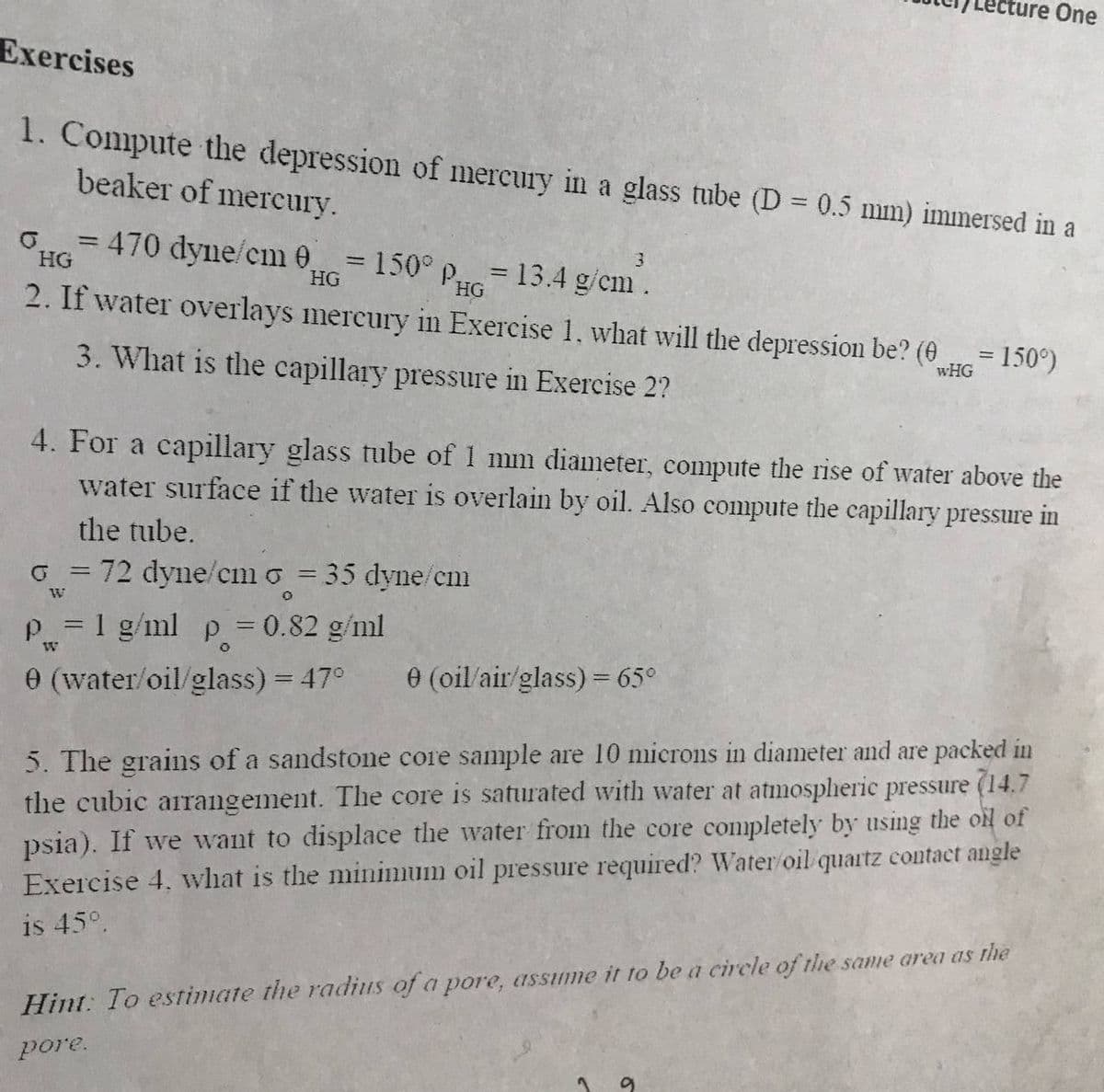1. Compute the depression of mercury in a glass tube (D = 0.5 mm) immersed in a beaker of mercury. 470 dyne/cm e =D150° PHG HG = 13.4 g/cm. %3D %3D %3D HG 2. If water overlays mercury in Exercise 1. what will the depression be? (e = 150°) wHG 3. What is the capillary pressure in Exercise 2?
1. Compute the depression of mercury in a glass tube (D = 0.5 mm) immersed in a beaker of mercury. 470 dyne/cm e =D150° PHG HG = 13.4 g/cm. %3D %3D %3D HG 2. If water overlays mercury in Exercise 1. what will the depression be? (e = 150°) wHG 3. What is the capillary pressure in Exercise 2?
Introduction to Chemical Engineering Thermodynamics
8th Edition
ISBN:9781259696527
Author:J.M. Smith Termodinamica en ingenieria quimica, Hendrick C Van Ness, Michael Abbott, Mark Swihart
Publisher:J.M. Smith Termodinamica en ingenieria quimica, Hendrick C Van Ness, Michael Abbott, Mark Swihart
Chapter1: Introduction
Section: Chapter Questions
Problem 1.1P
Related questions
Question

Transcribed Image Text:ecture One
Exercises
1. Compute the depression of mercury in a glass tube (D = 0.5 mm) immersed in a
beaker of mercury.
470 dyne/cm 0
%3D
3.
= 150° P.= 13.4 g/cm.
2. If water overlays mercury in Exercise 1, what will the depression be? (0
HG
%3D
HG
HG
= 150°)
3. What is the capillary pressure in Exercise 2?
wHG
4. For a capillary glass tube of 1 mm diameter, compute the rise of water above the
water surface if the water is overlain by oil. Also compute the capillary pressure in
the tube.
G = 72 dyne/cm o = 35 dyne/cm
%3D
P= 1 g/ml p = 0.82 g/ml
0 (water/oil/glass) = 47°
e (oil'air/glass) = 65°
5. The grains of a sandstone core sample are 10 microns in diameter and are packed in
the cubic arrangement. The core is saturated with water at atmosplheric pressure (14.7
psia). If we want to displace the water from the core completely by using the oil of
Exercise 4, what is the minimum oil pressure required? Water oil quartz contact angle
is 45°.
Hint: To estimate the radius of a pore, assume it to be a circle of the same area as the
pore.
Expert Solution
This question has been solved!
Explore an expertly crafted, step-by-step solution for a thorough understanding of key concepts.
Step by step
Solved in 4 steps

Recommended textbooks for you

Introduction to Chemical Engineering Thermodynami…
Chemical Engineering
ISBN:
9781259696527
Author:
J.M. Smith Termodinamica en ingenieria quimica, Hendrick C Van Ness, Michael Abbott, Mark Swihart
Publisher:
McGraw-Hill Education

Elementary Principles of Chemical Processes, Bind…
Chemical Engineering
ISBN:
9781118431221
Author:
Richard M. Felder, Ronald W. Rousseau, Lisa G. Bullard
Publisher:
WILEY

Elements of Chemical Reaction Engineering (5th Ed…
Chemical Engineering
ISBN:
9780133887518
Author:
H. Scott Fogler
Publisher:
Prentice Hall

Introduction to Chemical Engineering Thermodynami…
Chemical Engineering
ISBN:
9781259696527
Author:
J.M. Smith Termodinamica en ingenieria quimica, Hendrick C Van Ness, Michael Abbott, Mark Swihart
Publisher:
McGraw-Hill Education

Elementary Principles of Chemical Processes, Bind…
Chemical Engineering
ISBN:
9781118431221
Author:
Richard M. Felder, Ronald W. Rousseau, Lisa G. Bullard
Publisher:
WILEY

Elements of Chemical Reaction Engineering (5th Ed…
Chemical Engineering
ISBN:
9780133887518
Author:
H. Scott Fogler
Publisher:
Prentice Hall


Industrial Plastics: Theory and Applications
Chemical Engineering
ISBN:
9781285061238
Author:
Lokensgard, Erik
Publisher:
Delmar Cengage Learning

Unit Operations of Chemical Engineering
Chemical Engineering
ISBN:
9780072848236
Author:
Warren McCabe, Julian C. Smith, Peter Harriott
Publisher:
McGraw-Hill Companies, The